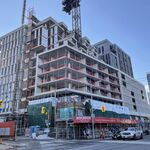Brandon716
Senior Member
^^^Those are all light rail, but the cars look smaller individually than the Bombardier Flexity cars. I'd have to research the Boston system to see how big they are.
The Eglinton daily demand is projected to be less than 200k
You're exactly right, I have been meaning to ask about this 400-500K figure. As I have mentioned in the Eglinton thread before, Boston's Green Line, even with multiple branches, is already bursting at its seams. The last thing they can do to increase capacity (other than implementing signal priority and perhaps a more efficient signalling system in the subway/elevated, which will help a bit but not much) is to triple-up the cars, which they had done on occasion in the past but for some reason have been generally reluctant to do so. The Central Subway is way past its original intended due date to be converted to a heavy rail subway, but instead, recent renovations and expansions have destroyed the old measures put in place to facilitate the conversion and it is now nowhere in sight in the future.I'm compiling a chart of NorthAmerican/Euro transit lines and their daily/yearly ridership that I'll post once I get more numbers. I have 63 lines so far, dozens and dozens more to go.
So far the busiest LRT line is the Green Line in Boston with around 270k per day (although it has four different branches...). Brandon you've been saying in the last few pages the Eglinton Line will be able to support 400-500k passengers a day (with 3 car trains) but I haven't found any NA/European LRT lines yet with that ridership. Do you know some examples? Perhaps there are some in Asia (Manilla?), but I'm guessing they would be entirely grade separated.
Most light rail lines carry under 100k passengers an average weekday (around 30-32 mil / year) and many are well below this mark. Eglinton's projected ridership is higher than many subway lines (even in Europe), significantly busier than the Canada Line projections, and is somewhere between the Metropolitan Line and the Circle Line in London.
Sheppard's daily ridership compares favourably with a number of subway lines, especially given its size. If you look at ridership per KM it outperforms pretty much every LRT line in NA (at least from the places I have looked at so far). Like Ansem posted earlier, our "Stubway" would be a successful line in other many cities.
Fine, does anyone know if TC's Eglinton LRT line is using the bigger Light Rail Tram Streetcars or the smaller Light Rail Tram Streetcars?
I've heard they are using the bigger Light Rail Tram Streetcars.
Toronto's buses are more utilized than many cities subways. Finch bus has a higher ridership than many of these places you compare us to.
The Eglinton daily demand is projected to be less than 200k. I'm not sure what numbers you were expecting it to be??
So the Green Line changed overnight from a streetcar/tramway system to an LRT system when they introduced the Boeing-Vertols, with minimal changes to the actual tracks, stations and signallings itself? How about the period when old trolleys, PCCs, BVs and the later Kinki-Sharyos were run at the same time? Was it a quasi-tramway-cum-LRT system?^^^Those are all light rail, but the cars look smaller individually than the Bombardier Flexity cars. I'd have to research the Boston system to see how big they are.
Which is why I think Eglinton LRT can actually be a success, but if they do 3 cars per train and run it with high frequency, all I'm saying is that it could reach up to 400k passengers/day without problem. Maybe 500k is an overestimate, but you can use the C-Train and the Docklands Light Rail as an example of higher capacity systems.
So the Green Line changed overnight from a streetcar/tramway system to an LRT system when they introduced the Boeing-Vertols, with minimal changes to the actual tracks, stations and signallings itself? How about the period when old trolleys, PCCs, BVs and the later Kinki-Sharyos were run at the same time? Was it a quasi-tramway-cum-LRT system?
The Green Line trains are each approximately 22 m x 2.5 m, usually coupled nowadays. That's longer, but comparably as wide as TTC's streetcars.
By bringing in the Portland LRT vs streetcar earlier and making general claims about LRT vs streetcar, you have already brought your own discussion beyond Flexity to the train technology in general.
How so, and how does it affect your LRT vs tram debate?The setup in Boston doesn't seem very similar to anything the TC planners have been considering.
Is the dedicated Eglinton LRT line going to be paved as well, to make it compatible with buses (as a backup)?




